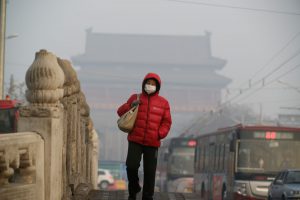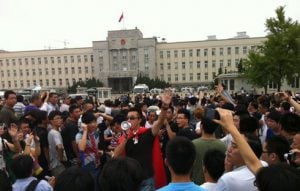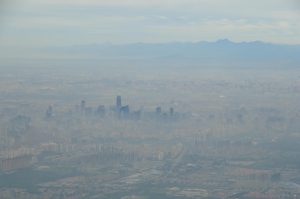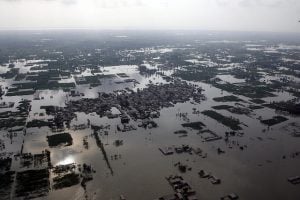As air quality hits record lows, the Chinese language has acquired a new word: “meter-busting”. Levels of pollutant PM2.5 have soared so high that monitoring equipment can no longer cope.
Central and eastern China is enveloped by smog. Of 74 Chinese cities which started reporting PM2.5 – fine particulate – levels on New Year’s Day, 33 have taken readings of over 300 micrograms per cubic metre in the two weeks since. Numbers above 300 are considered hazardous to human health.
The Beijing-Tianjin-Hebei triangle in the north of the country is suffering the worst of it. But from Shijiazhuang and Beijing in the north, to Nanjing in the south, via the central city of Wuhan, more than half of China is shrouded in smog.
Zhou Rong, climate and energy campaigner at Greenpeace, explained what’s behind the spike: “First of all, the north of China burns coal for heat during winter, leading to more pollution. On top of that, between Thursday and Saturday last week, an inversion layer formed [an atmospheric layer which prevents pollution dispersing], meaning pollution from Beijing, Tianjin and Hebei accumulated close to the ground.
“On Friday, pollution from the coal industry in Shanxi and Inner Mongolia blew in, and late on Saturday the same happened with heavy industry and coal-power pollution from southern Hebei.”
Zhou’s verdict was backed up at a Meteorology Bureau press conference held on Monday morning: “Conditions for dispersal were very poor from January 10 to 13. With low pressure at the surface, wind speeds fell, humidity increased and an inversion layer formed, causing pollution to accumulate,” a spokesperson said.
It was as if someone had put a lid on the city.
Regardless of the meteorological conditions, the fact that atmospheric pollutants were able to accumulate and cause problems of such severity and scale offers yet another warning about the state of China’s environment.
Beijing's air affected by surrounding areas
Beijing has actually done better than most cities on replacing coal with cleaner substitutes. In 2012, the city cut its coal consumption by 700,000 tonnes.
The 2008 Olympics were an effective spur. When it bid for the Games in 2001, the Chinese government promised that air quality would be good. Traffic restriction measures put in place then, and which continue today, gave many hope of seeing more “blue-sky days” ahead.
The data shows that during the Olympics, Beijing’s air quality was consistently up to standard, reaching Class I – the top grade – on 50% of days. This was the best it had been for a decade.
Beijing has some of the strictest vehicle emissions and fuel standards in China. On August 1 last year, cleaner diesel fuel was made available across the city in preparation for the fifth phase of a programme to cut the impacts of car exhausts.
Sign up to our newsletter
Want more stories like this in your inbox? Subscribe to chinadialogue's weekly newsletter to get the latest articles on China's environmental crisis.
Just a few years ago, Wang Qishan, then Beijing’s party secretary, would be rushed off his feet when the winter heating season started. Beijing was trying to replace coal-powered heating with natural gas, and it was his job to deal with gas shortages.
It’s a different story today. It took years to get them built, but four gas pipelines from Shaanxi, a province west of Beijing, have reduced the city’s reliance on coal. In early 2012, Beijing’s last four coal-powered power stations were marked for closure. Once their chimneys stop smoking, Beijing will be the first major city in China to have entirely dumped coal in favour of natural gas. Nowhere else is close to doing so.
Coal and cars are the two main sources of air pollution in Beijing, according to the city environmental protection bureau. Coal accounts for 16.7% of all air pollution, and vehicles for 22%. In winter months, the percentage ascribed to coal increases, as more is burned for heating.
In a country where coal-burning is the primary cause of atmospheric pollution, those figures are impressively low. But despite all those efforts, Beijing still finds itself stuck in smog.
The city is implementing an emergency response plan for days of severe pollution, attempting to cut government car journeys and industrial activity by a third, Li Hong, deputy chair of the city’s Economy and Information Technology Commission, told journalists on Monday. Fifty-eight firms have already halted work, Li added.
Speaking the same day, however, Yu Jianhua of the Beijing Atmospheric Environment Management Office said it was impossible to say how effective the emergency measures would be.
One of the difficulties in predicting the impact of the measures is that air pollution is mobile – it respects no boundaries – and Beijing is not isolated from surrounding pollution sources. “Recently, pollution to the south-west, south-east and south of Beijing has been significantly higher than that in the city itself,” explained Zhang Dawei, director of the Beijing Environmental Protection Monitoring Centre, at a press conference on Monday.
Shanxi and Inner Mongolia, to the west and north of the city, are now two major centres for the coal-chemical industry. Coke refineries here pump out constant fumes. Beijing’s neighbour, Hebei province, meanwhile hosts much of the heavy industry Beijing no longer wants, including metals conglomerate Shougang Steel. The industry relocations once thought to make economic and environmental sense are now mocked.
Local or regional efforts to keep the air clean are of little use for a simple reason: air moves.
Joint efforts yet to take effect
The January smog has sounded a warning about China’s attempts to deal with air pollution along administrative borders.
Ten years ago, in line with regulations on controlling air pollution, the State Environmental Protection Agency (which later became the Ministry of Environmental Protection) identified 113 key cities as focus areas for preventing atmospheric pollution. The list was approved by the State Council, China’s highest administrative body.
As this year’s smog rolled in, the Ministry of Environmental Protection was drawing on US experience to design a regionally based system that would identify cities meeting standards, and those not, and include a rolling programme of implementation and regular evaluations. But the most recent facts show that air pollution requires a macro solution. Policies and mechanisms need to be all-encompassing to succeed.
In 2001, in hope of winning the right to hold the Olympic Games, Beijing came up with a joint plan with the surrounding governments of Tianjin, Hebei, Shanxi, Inner Mongolia and Shaanxi. Some energy-hungry firms were to be partially or completely shut down, coal pollution tackled and sulphur and nitrogen-oxide scrubbing at power plants improved. With a successful Beijing Olympics as a goal, the results were excellent.
There have been other “joint” efforts. In 2010, eight ministries and commissions launched a coordinated attack on air pollution. And two years later, in December last year, the 12th Five Year Plan on Prevention and Control of Atmospheric Pollution in Key Regions was released by three arms of government: the Ministry of Environmental Protection, Ministry of Finance and the National Reform and Development Commission.
But not everyone is convinced that these joint assaults are working. Zhao Lijian, environmental management programme officer at the Energy Foundation, said effective action has so far been stymied by poor regional coordination: “Joint prevention requires information sharing and joint action. The MEP’s Environmental Protection Supervision Centres could take a coordinating role, but this has not been made part of their remit."
And in the short term, there is a chance of yet more smog, said Zhao. Other cities besides Beijing should come up with their own emergency response plans. But actually solving the problem will require wider emissions-reduction policies.



